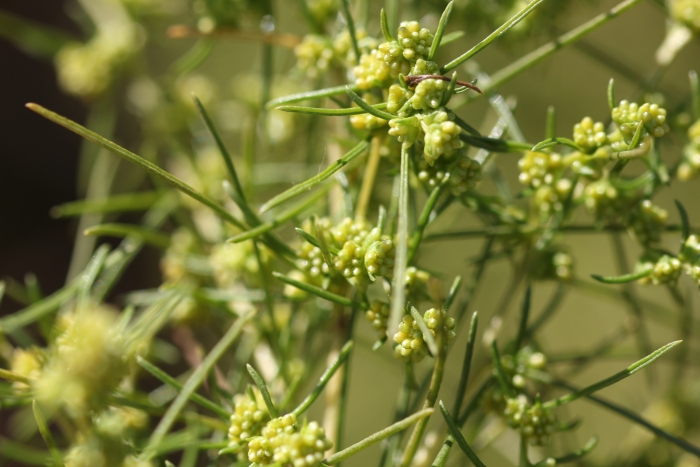Singlewhorl Burrobrush
(Ambrosia monogyra)
Singlewhorl Burrobrush (Ambrosia monogyra)
/
/

Millie Basden
CC BY 4.0
Image By:
Millie Basden
Recorded By:
Copyright:
CC BY 4.0
Copyright Notice:
Photo by: Millie Basden | License Type: CC BY 4.0 | License URL: http://creativecommons.org/licenses/by/4.0/ | Rights Holder: Millie Basden | Publisher: iNaturalist | Date Created: 2017-09-29T14:23:45-07:00 |















































Estimated Native Range
Summary
Ambrosia monogyra, commonly known as Singlewhorl Burrobrush, is a deciduous subshrub or shrub native to arid desert regions, often found in washes, alluvial fans, and scrublands in the Southwestern United States and Northwest Mexico. It typically grows up to 4 meters (13 feet) tall, with a sprawling habit that helps stabilize loose desert soils. The leaves of Singlewhorl Burrobrush are highly adapted to its dry environment; they are very thin, thread-like, and sometimes divided into thread-like lobes, which minimize water loss. The plant produces inconspicuous staminate flowers with translucent white corollas and more noticeable pistillate flowers that develop into rounded, fruit-bearing structures.
Singlewhorl Burrobrush is valued for its drought tolerance and ability to thrive in harsh desert conditions, making it suitable for xeriscaping and naturalistic desert gardens. It is also used for habitat restoration projects due to its soil stabilization properties. This plant prefers full sun to part shade and requires minimal water once established, making it an easy-care choice for gardeners in arid regions. It is adaptable to a variety of soils, provided they have good drainage. While not known for significant pest or disease problems, it can become sparse with overwatering or in too-rich soils.CC BY-SA 4.0
Singlewhorl Burrobrush is valued for its drought tolerance and ability to thrive in harsh desert conditions, making it suitable for xeriscaping and naturalistic desert gardens. It is also used for habitat restoration projects due to its soil stabilization properties. This plant prefers full sun to part shade and requires minimal water once established, making it an easy-care choice for gardeners in arid regions. It is adaptable to a variety of soils, provided they have good drainage. While not known for significant pest or disease problems, it can become sparse with overwatering or in too-rich soils.CC BY-SA 4.0
Plant Description
- Plant Type: Subshrub, Shrub
- Height: 10-12 feet
- Width: 8-10 feet
- Growth Rate: Moderate
- Flower Color: White
- Flowering Season: Spring
- Leaf Retention: Deciduous
Growth Requirements
- Sun: Full Sun, Part Shade
- Water: Low
- Drainage: Medium
Common Uses
Bee Garden, Bird Garden, Butterfly Garden, Low Maintenance
Natural Habitat
Native to arid desert regions, washes, alluvial fans, and scrublands
Other Names
Common Names:
Scientific Names: , Ambrosia monogyra, Hymenoclea monogyra, Hymenoclea monogyla,
GBIF Accepted Name: Ambrosia monogyra (Torr. & A.Gray) Strother & B.G.Baldwin